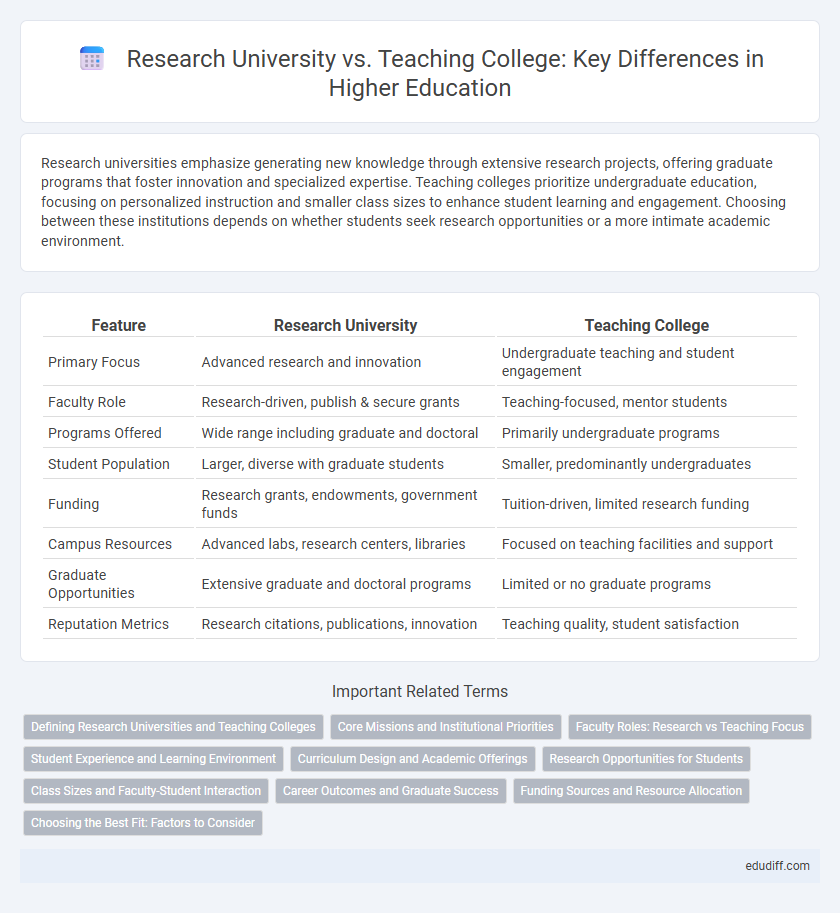Research universities emphasize generating new knowledge through extensive research projects, offering graduate programs that foster innovation and specialized expertise. Teaching colleges prioritize undergraduate education, focusing on personalized instruction and smaller class sizes to enhance student learning and engagement. Choosing between these institutions depends on whether students seek research opportunities or a more intimate academic environment.
Table of Comparison
| Feature | Research University | Teaching College |
|---|---|---|
| Primary Focus | Advanced research and innovation | Undergraduate teaching and student engagement |
| Faculty Role | Research-driven, publish & secure grants | Teaching-focused, mentor students |
| Programs Offered | Wide range including graduate and doctoral | Primarily undergraduate programs |
| Student Population | Larger, diverse with graduate students | Smaller, predominantly undergraduates |
| Funding | Research grants, endowments, government funds | Tuition-driven, limited research funding |
| Campus Resources | Advanced labs, research centers, libraries | Focused on teaching facilities and support |
| Graduate Opportunities | Extensive graduate and doctoral programs | Limited or no graduate programs |
| Reputation Metrics | Research citations, publications, innovation | Teaching quality, student satisfaction |
Defining Research Universities and Teaching Colleges
Research universities are institutions that prioritize the creation of new knowledge through extensive research activities and often offer a wide range of graduate and doctoral programs. Teaching colleges, also known as liberal arts colleges, primarily emphasize undergraduate education with a strong focus on personalized instruction and smaller class sizes. The distinction lies in research universities driving innovation and academic inquiry, while teaching colleges concentrate on fostering critical thinking and comprehensive learning experiences.
Core Missions and Institutional Priorities
Research universities prioritize advancing knowledge through extensive research activities, securing funding for innovative projects, and fostering graduate education to develop future scholars. Teaching colleges emphasize undergraduate instruction, prioritize personalized learning experiences, and focus on student success outcomes such as graduation rates and career readiness. Institutional priorities at research universities often include publishing impactful research and securing patents, whereas teaching colleges concentrate resources on curriculum development and faculty-student engagement.
Faculty Roles: Research vs Teaching Focus
Research University faculty prioritize producing original research, securing grants, and publishing in high-impact academic journals, contributing to the advancement of knowledge and innovation. Teaching College faculty emphasize delivering high-quality instruction, mentoring students, and developing engaging curricula to enhance learning outcomes and student success. Faculty workload at Research Universities often involves balancing research activities with teaching responsibilities, while Teaching Colleges allocate more time exclusively to pedagogical efforts.
Student Experience and Learning Environment
Research universities offer a dynamic learning environment characterized by extensive resources, cutting-edge laboratories, and faculty active in groundbreaking scholarship, which enriches the student experience through opportunities for hands-on research and interdisciplinary collaboration. Teaching colleges prioritize personalized instruction and smaller class sizes, fostering close faculty-student interactions that support deep engagement and tailored academic support. Students seeking immersive research opportunities benefit from research universities, while those valuing intimate learning settings may prefer teaching colleges for enhanced mentorship and focused academic development.
Curriculum Design and Academic Offerings
Research universities prioritize interdisciplinary curriculum design that integrates cutting-edge research with advanced theoretical frameworks, offering diverse graduate and doctoral programs. Teaching colleges emphasize a curriculum focused on foundational knowledge and skill development, primarily providing undergraduate degrees with smaller class sizes and experiential learning opportunities. This distinction shapes academic offerings, with research universities promoting innovation and specialized fields, while teaching colleges concentrate on broad-based education and personalized student engagement.
Research Opportunities for Students
Research universities offer extensive research opportunities for students, including access to funded projects, advanced laboratories, and partnerships with industry leaders. These institutions often provide undergraduate research programs, summer internships, and mentorship from faculty active in cutting-edge research. Teaching colleges typically emphasize classroom instruction and may offer fewer resources and less institutional support for student research initiatives.
Class Sizes and Faculty-Student Interaction
Research universities typically have larger class sizes, especially in introductory courses, which can limit personalized faculty-student interaction and encourage more independent learning. Teaching colleges emphasize smaller class sizes that foster direct engagement, allowing faculty to provide tailored feedback and mentorship. This environment enhances collaborative learning and supports student academic development through closer faculty relationships.
Career Outcomes and Graduate Success
Research universities often provide students with access to extensive resources, cutting-edge laboratory facilities, and opportunities for original research, which can lead to stronger credentials and higher earning potential in STEM and academic careers. Teaching colleges emphasize smaller class sizes and personalized instruction, fostering close faculty mentorship that enhances skills like critical thinking and communication, benefiting graduates pursuing professional fields or further education. Graduate success at research universities frequently hinges on networking and publication opportunities, while teaching colleges excel in nurturing practical experience and teaching excellence that translates to diverse career pathways.
Funding Sources and Resource Allocation
Research universities primarily depend on diversified funding sources such as federal research grants, industry contracts, and endowments, enabling substantial investment in advanced laboratories and specialized faculty. Teaching colleges often rely more on tuition revenue and state appropriations, which prioritize instructional resources and student support services over expansive research infrastructure. The allocation of funds at research universities favors innovation and exploratory projects, while teaching colleges focus budgetary resources on curriculum development and personalized learning environments.
Choosing the Best Fit: Factors to Consider
When choosing between a research university and a teaching college, prospective students should evaluate their academic and career goals, as research universities prioritize advanced research opportunities and graduate programs, while teaching colleges emphasize undergraduate education and smaller class sizes. Factors such as faculty expertise, institutional resources, internship availability, and campus culture play crucial roles in aligning with a student's learning style and professional aspirations. Understanding the differences in funding, campus facilities, and networking opportunities helps ensure the best fit for long-term academic success and personal growth.
Research University vs Teaching College Infographic

 edudiff.com
edudiff.com